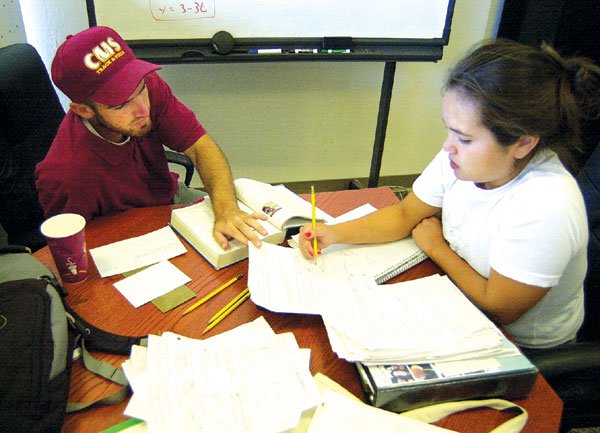David Payne, owner of Extreme Learning, Inc. in Morgan Hill can
sum up everything the average test taker needs to know in three
words.
”
Practice, practice, practice,
”
said Payne, a former assistant principal for Gilroy High School
who now helps elementary through high school students perform
better on tests of all kinds, from their third-grade history exam
to the SAT.
David Payne, owner of Extreme Learning, Inc. in Morgan Hill can sum up everything the average test taker needs to know in three words.
“Practice, practice, practice,” said Payne, a former assistant principal for Gilroy High School who now helps elementary through high school students perform better on tests of all kinds, from their third-grade history exam to the SAT.
Practice is only one part of the equation for a student’s success on standardized testing, and long school breaks like summer vacation are the ideal time to get in plenty of vital study time before sitting down to expensive tests with potentially life-altering consequences.
For many South Valley students, this is the time to do just that, because when the test clock is ticking, the pressure starts.
Most of these tests can be re-taken, but each has important strings attached. Performance on the SAT can determine students ability to get into the colleges of their choice, and their performances on tests like the GRE, LSAT, GMAT and MCAT can determine their abilities to get into the graduate or professional schools of their choice after that.
Students on summer break or fresh out of college can make sure to maximize their scores on major voluntary exams with a little extra time and effort spent toiling over their desks rather than working on their tans.
Average students in one of Payne’s classes, he said, sees a score jump of 200 points on their SAT tests.
Students can make the most of their time by following a five-step study program, said Jerry Bobrow, author of more than 40 books on the field of test preparation and executive director of Bobrow Test Preparation Services, a Woodland Hills, Calif.-based test prep service with classes throughout the state.
Step One: Awareness
Students should know everything they can about a test before the day they show up for the exam, said Bobrow, who started his career as a middle school teacher.
“They should know what materials they should take with them, the length of the sessions, and whether or not there’s a penalty for guessing,” said Bobrow. “There shouldn’t be any surprises when they get into the test. Awareness helps them with being comfortable, and when they can go into the test comfortable they’ll do a better job.”
For example, the SAT will penalize students for guessing, so they should attempt to eliminate as many answers as possible from multiple choice questions before selecting an answer.
On the other hand, the GRE, which is a computer-based test, will not allow students to advance unless they give an answer to each question.
Spending too much time on one that they’re not sure of could cost them valuable chances at a higher score later on.
Step Two: Know
your basic skills
Exams like the SAT’s test basic skills that many students are already familiar with, but as students progress into college and beyond, more time may have elapsed since their last class on a given topic. Math, for instance, is a major problem area for college students facing the GRE, many of whom have not taken a math class since early in their college careers, said Bobrow.
Catching up with a tutor can help to bridge the gap, and many test prep services, like Payne’s Extreme Learning, conduct diagnostic testing to see whether a student is facing a learning gap.
“The new SAT has Algebra II included in it, and the old one didn’t,” said Payne. “That’s an important change, particularly for high school juniors who may be going in to Algebra II, but who are recommended to take the test at the beginning of their junior year. That’s the boat my daughter is in, so she’s going to get a head start on the Algebra II concepts by getting some tutoring on them this summer.”
Step Three: Know
your test writer
“We’ve all had friends who took the same tests we did and really did well on their exams even though they didn’t study,” said Bobrow. “Most of the time, if you ask those kinds of people how they did it, they say something like, ‘I just got where the professor was going.’ In the same way, you want to know where the test writer is coming from.”
There are plenty of information and strategy books available for nearly every test, from the GMAT to the Postal Employee Exam, each of which will help to give readers an insight into the program. Payne recommends those by the Princeton Review and Kaplan.
Step Four: Strategies and techniques
The same books that will tell a student what kind of test writers they’re dealing with will also give the student clues to reading the questions of those writers appropriately, and simple strategies that can help the student avoid losing points to carelessness.
“You want to have practiced these things enough that they’re pretty automatic,” said Bobrow. “On a paper and pencil test, you want to make sure you’re always circling or underlining all the things you’re looking for in a sentence, like if a sentence reads, ‘All of the following are false except,’ you’ll want to circle the word except.”
Step Five: Practice, practice, practice!
Payne’s motto is shared by Bobrow, whose curriculum has been administered in California State Universities for 30 years.
“It’s important to sit down and plan a realistic study schedule with consistent, quality study time,” said Bobrow. “If you’re going to do your reviews at night, you need to limit them to two or, at the most, two and a half hours. There’s only so much that you’re going to get done in a day, but you can crank it up a bit as the test gets closer to make sure you peak at the right time.”
Just don’t wait too long, said Payne.
“One of the things that happens is people wait until a few weeks before the test and then decide they want to start preparing,” said Payne. “We do offer one-on-one tutoring for students in that boat, but it’s so much better for students who start preparing sooner. There’s sort an absorption level that you reach. You can only take in so many vocabulary words in a day or a week.”
Test preparation courses are available for students who are unsure of studying on their own or who prefer a more human touch to the process. Payne charges $200 for his SAT prep class, which will run this summer at his office in Morgan Hill as well as at Solarsano Middle School in Gilroy.
For more information on test preparation courses through Bobrow’s company, Bobrow Test Preparation Services, visit the company’s Web site at www.BobrowTest.com for a complete listing of local programs, most of which take place over three to four weekends and cost between $225 and $350.














